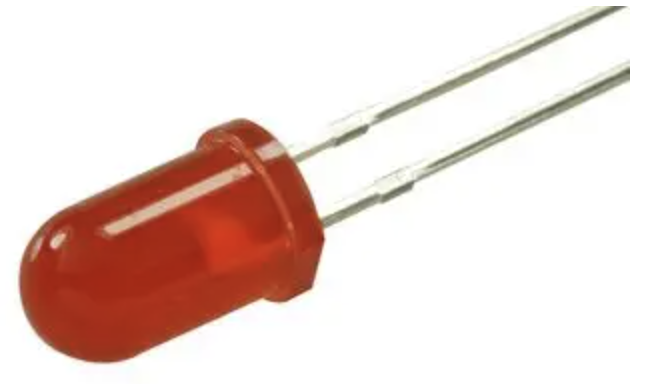When we connect an LED to to a battery, we often need to connect a resistor is series to limit the current. I saw this question come up in a facebook group, and thought it might be useful to use this as a simple illustrative example of doing circuit design.
The basic circuit we will be considering is shown below:

We have a current ![]() leaving the battery/voltage source, passing through the resistor giving a voltage drop of
leaving the battery/voltage source, passing through the resistor giving a voltage drop of ![]() , then passing through the LED with a voltage drop of
, then passing through the LED with a voltage drop of ![]() before returning to the battery. So, how can we work out the value of the resistor we should use?
before returning to the battery. So, how can we work out the value of the resistor we should use?
To answer that question, we need to know some things about the LED. Specifically:
- how much current do we want to be passing through the LED?
- what will be the voltage across the LED at that current?
How can we find the answer to those questions? We need to refer to the datasheet of the LED component!
First let’s check the maximum rating for the component. Looking at the datasheet, we see the following table:


The graph in figure 3 shows us how bright the LED will be at various currents. At 10mA, the intensity of the LED light is said to be at a normalised level of 1. If we increase the current to ![]() , then the LED will be around 1.5 times as bright as the
, then the LED will be around 1.5 times as bright as the ![]() level. Increasing the current to
level. Increasing the current to ![]() (the max) then the intensity is only around 1.8 times as bright at the intensity at
(the max) then the intensity is only around 1.8 times as bright at the intensity at ![]() , so it is consuming a lot more power for little gain. At
, so it is consuming a lot more power for little gain. At ![]() , we still get a bright intensity while leaving a fair amount of headroom below the maximum, so let’s design our circuit to have a current:
, we still get a bright intensity while leaving a fair amount of headroom below the maximum, so let’s design our circuit to have a current:
![]()
What will be the voltage across the LED at that current? Referring to the graph in figure 2, we see that the voltage across the LED will be approximately:
![]()
What will be the voltage across the resistor of ![]() ohms? We know the current through the resistor must be
ohms? We know the current through the resistor must be ![]() , so we can use Ohm’s law to work out the voltage drop across the resistor:
, so we can use Ohm’s law to work out the voltage drop across the resistor:
![]()
We can now use Kirchoff’s voltage law, which says the sum of voltages in a loop is always equal to ![]() . If we go clockwise around the circuit, the voltage source helps the current and is therefore positive, whereas the resistor and LED oppose the current, so their signs are negative. The equation becomes:
. If we go clockwise around the circuit, the voltage source helps the current and is therefore positive, whereas the resistor and LED oppose the current, so their signs are negative. The equation becomes:
![Rendered by QuickLaTeX.com \[\begin{split} V - V_R - V_{f_{LED}} & = 0 \\V - i \times R - V_{f_{LED}} & = 0 \\i \times R &= V - V_{f_{LED}} \\R & = \frac{V - V_{f_{LED}}}{i} \\\end{split}\]](https://www.teachmaths.org/wp-content/ql-cache/quicklatex.com-26e9802f8e39e106431e7d8cb223b60f_l3.png)
If we assume we are using a ![]() battery, then substituting in the numbers gives us:
battery, then substituting in the numbers gives us:
![Rendered by QuickLaTeX.com \[\begin{split}R & = \frac{(9 - 2)}{20 \times 10^{-3}} \\ & = 350 \Omega\end{split}\]](https://www.teachmaths.org/wp-content/ql-cache/quicklatex.com-64239d204537cbe59376eab061a040b4_l3.png)
For safety, we can round it up to the nearest preferred value, which would be a ![]() resistor with colour code orange-white-brown. Double-checking the current, we get:
resistor with colour code orange-white-brown. Double-checking the current, we get:
![Rendered by QuickLaTeX.com \[\begin{split} i & = \frac{V - V_{f_{LED}}}{R} \\& = \frac{(9 - 2)}{390} \\& = 18mA\end{split}\]](https://www.teachmaths.org/wp-content/ql-cache/quicklatex.com-91bcf4242c652bb92e9df160d5da7208_l3.png)
This is still acceptable. So, we have now completed our circuit design:


